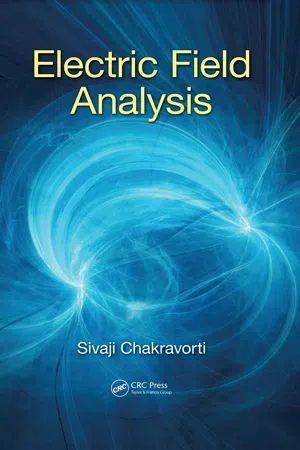
- 568 pages
- English
- ePUB (mobile friendly)
- Available on iOS & Android
Electric Field Analysis
About this book
Electric Field Analysis is both a student-friendly textbook and a valuable tool for engineers and physicists engaged in the design work of high-voltage insulation systems. The text begins by introducing the physical and mathematical fundamentals of electric fields, presenting problems from power and dielectric engineering to show how the theories are put into practice. The book then describes various techniques for electric field analysis and their significance in the validation of numerically computed results, as well as:
- Discusses finite difference, finite element, charge simulation, and surface charge simulation methods for the numerical computation of electric fields
- Provides case studies for electric field distribution in a cable termination, around a post insulator, in a condenser bushing, and around a gas-insulated substation (GIS) spacer
- Explores numerical field calculation for electric field optimization, demonstrating contour correction and examining the application of artificial neural networks
- Explains how high-voltage field optimization studies are carried out to meet the desired engineering needs
Electric Field Analysis is accompanied by an easy-to-use yet comprehensive software for electric field computation. The software, along with a wealth of supporting content, is available for download with qualifying course adoption.
Frequently asked questions
- Essential is ideal for learners and professionals who enjoy exploring a wide range of subjects. Access the Essential Library with 800,000+ trusted titles and best-sellers across business, personal growth, and the humanities. Includes unlimited reading time and Standard Read Aloud voice.
- Complete: Perfect for advanced learners and researchers needing full, unrestricted access. Unlock 1.4M+ books across hundreds of subjects, including academic and specialized titles. The Complete Plan also includes advanced features like Premium Read Aloud and Research Assistant.
Please note we cannot support devices running on iOS 13 and Android 7 or earlier. Learn more about using the app.
Information
1
Fundamentals of Electric Field
1.1 Introduction
Table of contents
- Cover
- Half Title
- Title Page
- Copyright Page
- Table of Contents
- Foreword
- Preface
- Author
- 1. Fundamentals of Electric Field
- 2. Gauss’s Law and Related Topics
- 3. Orthogonal Coordinate Systems
- 4. Single-Dielectric Configurations
- 5. Dielectric Polarization
- 6. Electrostatic Boundary Conditions
- 7. Multi-Dielectric Configurations
- 8. Electrostatic Pressures on Boundary Surfaces
- 9. Method of Images
- 10. Sphere or Cylinder in Uniform External Field
- 11. Conformal Mapping
- 12. Graphical Field Plotting
- 13. Numerical Computation of Electric Field
- 14. Numerical Computation of High-Voltage Field by Finite Difference Method
- 15. Numerical Computation of High-Voltage Field by Finite Element Method
- 16. Numerical Computation of High-Voltage Field by Charge Simulation Method
- 17. Numerical Computation of High-Voltage Field by Surface Charge Simulation Method
- 18. Numerical Computation of Electric Field in High-Voltage System – Case Studies
- 19. Electric Field Optimization
- Index